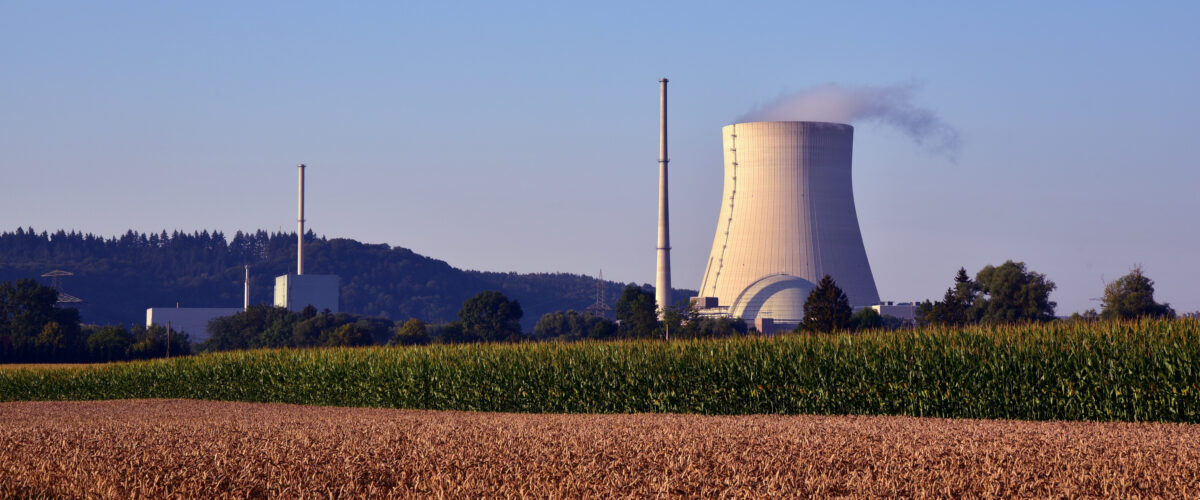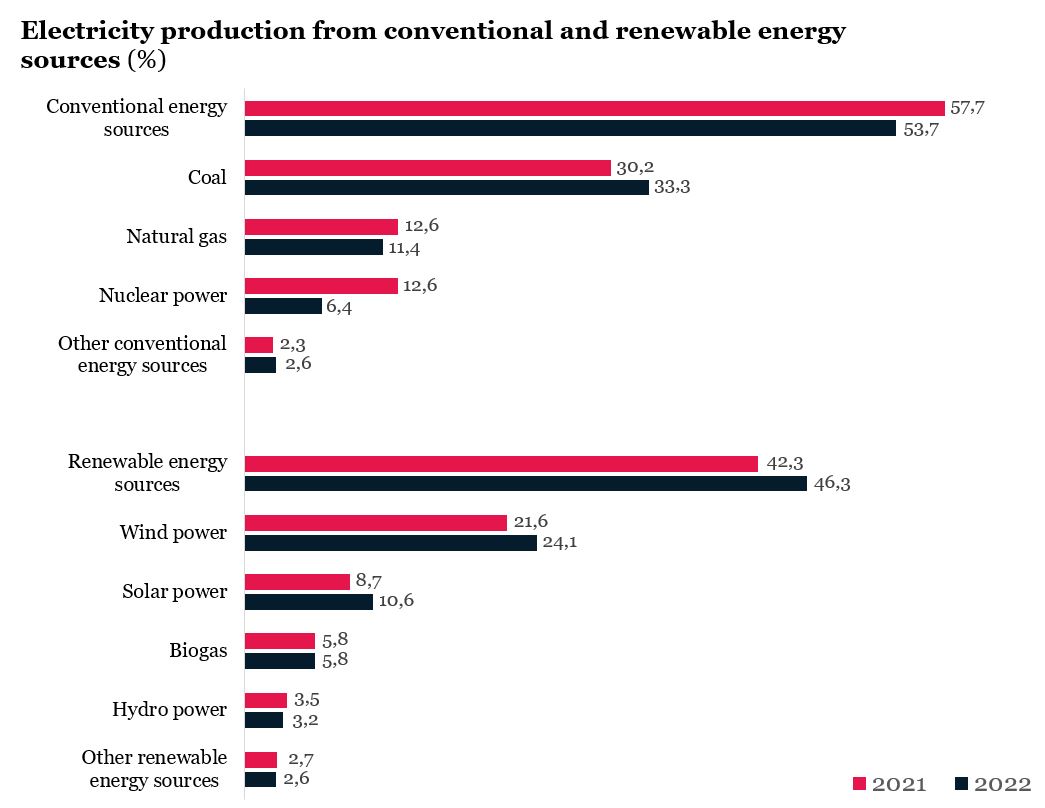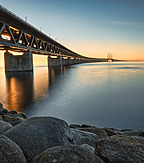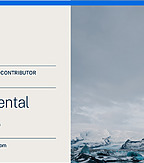Article | 19 April 2023
Germany closes its last nuclear power plants – with a debated outcome

On 15 April 2023, the last three active nuclear power plants in Germany were shut down. The era of nuclear power, whose fate has been decided since the German government’s decision in 2011 to switch entirely to renewable energy sources (“Energiewende”), has thus come to an end. The coming winter will be the first without German nuclear electricity, which has raised supply concerns both among private individuals and the industry.
But Germany’s energy transition has also given rise to a broader discussion about the future of sustainability and environmental responsibility. The transition is an opportunity for Germany, the EU’s largest and the world’s fourth largest economy, to position itself on the climate issue both within the Union and globally. At the same time, Germany hopes that the transition will lead to strengthened innovation for sustainable solutions.
Whether the transition will be fully implemented on time and without creating bottlenecks that paralyse the entire initiative, however, is under debate. Currently, conventional energy sources such as coal, nuclear power and natural gas still account for more than half of the electricity produced in Germany. A clear consequence of this is that the conditions for the development of climate-friendly projects will continue to be very favourable.
Energy prices have generally risen in most parts of Europe since 2021. There are several reasons for this, not at least the war in Ukraine, which led to reduced imports of Russian gas. However, domestic shortages in hydropower and nuclear power production also forced prices upward in the EU. At the same time, energy demand increased as the global economy began its recovery from the COVID-19 pandemic. The obvious role that electricity plays in modern societies resulted in the price increases quickly being felt by all actors in society – from private individuals to large industries.
While many EU countries, including Sweden, continue to rely on nuclear power, the last three active nuclear power plants in Germany were shut down on 15 April 2023. The decision to phase out nuclear power over a 10-year period was taken in the aftermath of the Fukushima nuclear disaster in 2011. The German nuclear power plants were supposed to be shut down in 2022, but the Russian invasion of Ukraine in 2021 prompted a temporary extension decision in the German parliament.
Public Opinion on Energiewende and Nuclear Shut Down
In the discussion regarding the phase out of nuclear power, there has been a notable split in Germany between those who have confidence in the transition to renewable energy sources and those who fear it. Widespread worries are that electricity prices will rise further and that supply will be insufficient at times, resulting in power cuts and higher dependence on imported electricity.
Not all Member States in the EU have chosen to go the German way. Advocates of nuclear power highlight the role that the energy source can play in the fight against climate change and its importance for future energy production. In the EU, these advocates include Belgium, Bulgaria, Finland, France, Italy, Croatia, the Netherlands, Poland, Romania, Slovakia, Slovenia, and the Czech Republic. Sweden also belongs to the countries with a positive disposition towards nuclear power. In addition to Germany, Spain and Austria are critical towards nuclear power.
The German Energy Mix
Although nuclear power only accounted for 6.4% of the electricity generation in Germany in 2022 (cf. 12.6% in 2021), there is still a strong scepticism whether and how Germany’s energy needs can be met by renewable energy sources alone. In 2022, the conventional energy sources coal, nuclear power and natural gas still accounted for more than half of the electricity generation in Germany. In 2022, the main renewable energy sources were wind power (24.1%), solar energy (10.6%), biogas (5.8%) and hydro power (3.2%).

Source: Destatis, 2023
The ruling traffic light coalition in Germany, consisting of the Social Democratic Party of Germany (SPD), the liberal Free Democratic Party (FDP) and the green Alliance 90/The Greens (Bündnis 90/Die Grünen), has made the expansion of renewables one of its main ambitions. The target is for 80% of the German electricity production to come from renewable energy sources by 2030.
Obstacles to the German Energy Transition Plans
A sad truth that Germany is forced to witness again and again is that a strong will does not always suffice to succeed. Despite the country’s far-reaching ambitions, there are several obstacles that significantly complicate and risk paralysing the entire transition initiative. The following three factors appear to be particular challenges for the transition.
- Lack of Capacity
A key difficulty for the German transition to fully rely on renewable energy sources is the lack of capacity of the German electricity grids. This applies to all parts of the electricity transport chain, i.e., the national grid (the electricity grid’s equivalent of an “Autobahn”), the regional grids (the electricity grid’s equivalent of national highways) and the local networks (the electricity grid’s equivalent of local streets). The problem is reinforced by the fact that German electricity production is mainly located in the north and north-east of the country, while the heavy industry and the economic centre are in the south and west. Two of the nuclear power plants that were shut down on 15 April 2023 are located in southern Germany.
Historically, a large part of German wind power has been built in the north where conditions have been favourable. This also goes for a lot of the wind power projects planned to be built in the coming years. The existing power lines of today already lack the capacity to bring the entire electricity produced from wind power to where it is needed the most, a shortage that will only become more noticeable as the share of wind power produced electricity increases.
It is thus clear that the expansion of the German electricity grids is a prerequisite for the successful transition to renewable energy sources. However, the progress of this expansion is very slow. Germany’s federal constitution entails bureaucratic disadvantages, with the planning of power lines and the respective approval decisions to some extent being taken at federal level. For a long time, the Bavarian State Government blocked a power line that was to be laid through the federal state, and eventually demanded that the power cable be laid underground over long distances, triggering new planning and approval processes. At the same time, expansion projects are regularly accompanied by public protests and court proceedings, which also cause considerable delays.
- Permit Approval Processes
Another major difficulty for the development and expansion of renewable energy sources in Germany is the time required before construction can begin. The planning stages and permit approval processes usually take several years – for wind farms, on average between four and five years. Attempts are being made by the federal government to lower the bureaucratic obstacles, but much work remains to be done.
In March 2023, a law was passed with the aim of scaling down the planning and permit approval stages for on- and offshore wind farms, for connection lines from offshore wind farms to the onshore energy grid, and for solar energy facilities. The hope is that the new law will reduce the time required in these processes by one to two years.
Furthermore, the coalition government has stipulated a statutory target that two percent of Germany’s land area are to be set aside for onshore wind power by 2032. However, it is questionable whether this target will be achieved in time, as the figure currently stands at less than one per cent, and because there are several ways in which unwilling parties can impede and delay these projects.
- “Kohleausstieg 2030” – The Coal Phase Out
The third major difficulty in ensuring the German energy transition towards purely renewable energy sources is the ambitious goal of phasing out the use of coal by 2030 (“Kohleausstieg 2030”). The phase out is necessitated both by stricter climate targets to reach the 2030 goals and the EU Emissions Trading System, which will increasingly restrict the conditions for the use of coal.
It is clear that a transition to renewable energy sources does not include coal-fired power stations. However, as can be seen from the table above, coal accounted for 33.3% of the German energy mix in 2022. The coalition government’s ambition to solve this shortage is by building new gas power plants that can initially run on natural gas and in the future be repurposed for running on climate-neutral hydrogen. The new power plants are planned to be built close to existing power plants to take advantage of existing infrastructure. So far, however, it has proved difficult to find willing investors for these types of projects, as power plants generally risk being used less as the share of alternative renewable energy sources increases.
Setterwalls’ Comments
Germany’s decision to close the last nuclear power plants will make the country dependent on electricity imports from other countries – including Sweden, which in 2022 exported the most electricity of the countries in Europe. Wind power accounted for a large part of the Swedish surplus. The conditions for Swedish electricity exports should continue to be excellent, not least because Sweden has a high proportion of electricity from renewable energy sources, a source that is highly valued and in great demand in countries like Germany. At the same time, Germany’s need for electricity imports could lead to political tensions, especially if the imported electricity originates from nuclear power plants. Already today, Germany imports nuclear electricity from France.
As the use of electricity increases ever further, it is a fact that the demand for electricity, not at least from renewable sources, will increase. Electric vehicles, data centres and heating devices for household are some of the most obvious use cases, but the fields of electricity application will continue to expand. And with these applications, the demand for renewable energy sources and climate-friendly solutions will increase. Thus, the conditions for running these types of construction projects will continue to be very favourable.
Setterwalls monitors these issues on an ongoing basis, and you are welcome to contact us for further information on how your business may be affected by the developments.
Contact:


